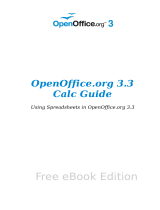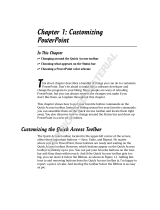Page is loading ...

OpenOffice.org 3
Impress Guide
This PDF is designed to be read onscreen, two pages at a
time. If you want to print a copy, your PDF viewer should
have an option for printing two pages on one sheet of
paper, but you may need to start with page 2 to get it to
print facing pages correctly. (Print this cover page
separately.)
Alternatively, you can download a free PDF of the printed
edition or buy a low-cost printed copy from
http://stores.lulu.com/opendocument. You can also
download an editable (.odt) version of this book from
http://oooauthors.org/en/authors/userguide3/published/

Copyright
This document is Copyright © 2007–2009 by its contributors as listed
in the section titled Authors. You may distribute it and/or modify it
under the terms of either the GNU General Public License, version 3 or
later, or the Creative Commons Attribution License, version 3.0 or
later. All trademarks within this guide belong to their legitimate
owners.
Authors
Agnes Belzunce
Martin J Fox
Peter Hillier-Brook
Dan Lewis
Gary Schnabl
Jean Hollis Weber
Michele Zarri
Feedback
Please direct any comments or suggestions about this document to:
Publication date and software version
Published 27 January 2009. Based on OpenOffice.org 3.0.
You can download
an editable version of this document from
http://oooauthors.org/en/authors/userguide3/published/

Contents
Chapter 1
Introducing Impress...................................................................7
What is Impress?.................................................................................8
Parts of the main Impress window......................................................8
Creating a new presentation.............................................................17
Formatting a presentation................................................................21
Running the slide show.....................................................................27
Chapter 2
Using Slide Masters, Styles, and Templates.............................28
Designing a presentation..................................................................29
What are slide masters?....................................................................29
What are styles? Why use them?.......................................................30
Working with slide masters...............................................................32
Modifying a slide master...................................................................34
Choosing and applying the background............................................35
Modifying default text areas.............................................................38
Adding text to all slides.....................................................................41
Working with styles...........................................................................42
Working with templates....................................................................46
Chapter 3
Adding and Formatting Text.....................................................53
Introduction......................................................................................54
Working with text boxes....................................................................54
Inserting text....................................................................................57
Formatting text.................................................................................60
Creating bulleted and numbered lists...............................................70
Using tables......................................................................................77
Using fields.......................................................................................83
Using hyperlinks...............................................................................85
Chapter 4
Adding and Formatting Pictures..............................................88
Introduction......................................................................................89
Inserting pictures..............................................................................89
Formatting pictures..........................................................................93
OpenOffice.org Impress Guide 3

Creating an image map.....................................................................99
Managing the Gallery themes.........................................................101
Chapter 5
Creating Graphic Objects.......................................................104
Introduction....................................................................................105
The Drawing toolbar.......................................................................105
Creating lines and shapes...............................................................108
Working with connectors................................................................109
Working with 3D shapes.................................................................111
Grouping shapes together...............................................................113
Arranging shapes............................................................................113
Flipping shapes...............................................................................114
Aligning shapes...............................................................................115
Alignment using the grid and snap guides......................................115
Converting an object to a different type.........................................117
Setting up interaction with a shape or image.................................118
Animating images...........................................................................120
Using Fontwork...............................................................................122
Chapter 6
Formatting Graphic Objects...................................................127
Introduction....................................................................................128
Using graphics styles to format graphics........................................128
Formatting lines and shapes...........................................................130
Moving, resizing and rotating a graphic object..............................130
Formatting lines..............................................................................134
Formatting areas.............................................................................138
Formatting text...............................................................................151
Formatting connectors....................................................................153
Chapter 7
Inserting Spreadsheets, Charts, and Other Objects...............155
Using spreadsheets in Impress.......................................................156
Inserting a chart.............................................................................163
Inserting other objects....................................................................173
Inserting the contents of a file........................................................178
4 OpenOffice.org Impress Guide

Chapter 8
Adding and Formatting Slides, Notes and Handouts.............179
Introduction....................................................................................180
Adding, renaming, and removing slides..........................................181
Creating slides from an outline.......................................................186
Modifying slides..............................................................................188
Adding and formatting notes..........................................................192
Creating handouts..........................................................................197
Chapter 9
Slide Shows.............................................................................202
Putting together a slide show.........................................................203
Using slide transitions....................................................................209
Using slide animation effects..........................................................211
Using interactions...........................................................................221
Running a slide show......................................................................222
Chapter 10
Printing, e-mailing, exporting, and saving slide shows.........225
Introduction....................................................................................226
Quick printing.................................................................................226
Controlling printing........................................................................226
Printing a brochure.........................................................................230
Exporting to PDF............................................................................231
Exporting as a Flash file.................................................................237
Exporting as web pages (HTML files).............................................238
E-mailing a presentation.................................................................241
Opening and saving a PowerPoint file.............................................243
Chapter 11
Setting Up and Customizing Impress.....................................245
Choosing options that affect all of OOo..........................................246
Choosing options for Impress.........................................................248
Customizing the user interface.......................................................253
Adding functionality with extensions..............................................262
Appendix A
Keyboard Shortcuts................................................................265
Introduction....................................................................................266
OpenOffice.org Impress Guide 5

Function keys for Impress...............................................................266
Other shortcut keys for Impress.....................................................267
Shortcut keys in the Normal View..................................................268
Shortcut keys in slide shows...........................................................269
Navigating in the Slide Sorter........................................................269
Index.........................................................................................270
6 OpenOffice.org Impress Guide

Chapter 1
Introducing Impress

What is Impress?
Impress is OpenOffice.org’s presentations (slide show) component. You
can create slides that contain many different elements, including text,
bulleted and numbered lists, tables, charts, clip art, and a wide range
of graphic objects. Impress, in common with the other components of
OpenOffice.org, has access to the spelling checker and thesaurus and
comes with pre-packaged text styles, background styles, and a handy
online help.
This chapter introduces the Impress user interface and describes how
to create a simple slide show using the Presentation Wizard.
To use Impress for more than very simple slide shows, refer to the
other chapters in this guide for explanations of the program’s many
features.
Note
Drawings are created in the same way with Impress as they are
with Draw. Refer to the
Draw Guide
for details on how to use the
drawing facilities.
Parts of the main Impress window
The main Impress window (Figure 1) has three parts: the
Slides pane
,
the
Workspace
, and the
Tasks pane
. Additionally, several toolbars can
be displayed or hidden during the creation of a presentation.
Tip
You can remove the
Slides pane
or
Tasks pane
from view by
clicking the
X
in the upper right corner. You can also show or
hide these panes using View > Slide Pane or View > Task
Pane.
Slides pane
The
Slides pane
contains thumbnail pictures of the slides in your
presentation, in the order they will be shown (unless you change the
order, as described in Chapter 9). Clicking a slide in this pane selects it
and places it in the
Workspace
. While it is there, you can apply any
changes desired to that particular slide.
8 OpenOffice.org Impress Guide

Figure 1: Main window of Impress
Several additional operations can be performed on one or more slides
in the Slides pane:
• Add new slides at any place within the presentation after the first
slide.
• Mark a slide as hidden so that it will not be shown as part of the
slide show.
• Delete a slide from the presentation if it is no longer needed.
• Rename a slide.
• Copy or move the contents of one slide to another (copy and
paste, or cut and paste, respectively).
It is also possible to perform the following operations, although there
are more efficient methods than using the Slides pane as you will see
in this chapter.
• Change the slide transition following the selected slide or after
each slide in a group of slides.
• Change the sequence of slides in the presentation.
• Change the slide design. (A window opens allowing you to load
your own design.)
• Change slide layout for a group of slides simultaneously. (This
requires using the Layouts section of the Tasks pane.)
Chapter 1 Introducing Impress 9

Tasks pane
The
Tasks pane
has five sections:
Master Pages
Here you define the page style for your presentation. Impress
contains 28 prepackaged Master Pages (slide masters). One of them
—Default—is blank, and the rest have a background.
Tip
Press
F11
to open the Styles and Formatting window, where you
can modify the styles used in any slide master to suit your
purposes. This can be done at any time. See Chapter 2 for more
information.
Layout
Twenty prepackaged layouts are shown. You can choose the one you
want, use it as it is or modify it to your own requirements. At
present it is not possible to create custom layouts.
Table Design
Eleven standard table styles are provided in this pane. You can
further modify the appearance of a table with the selections to show
or hide specific rows and columns, or to apply a banded appearance
to the rows and columns.
Custom Animation
A variety of animations for selected elements of a slide are listed.
Animation can be added to selected elements of a slide, and it can
also be changed or removed later.
Slide Transition
Fifty-six transitions are available, including
No Transition
. You can
select the transition speed (slow, medium, fast). You can also choose
between an automatic or manual transition, and how long you want
the selected slide to be shown (automatic transition only).
Workspace
The
Workspace
has five tabs: Normal, Outline, Notes, Handout, and
Slide Sorter, as seen in Figure 9. These five tabs are called View
Buttons. There are also many toolbars that can be used during slide
creation; they are revealed by selecting them with View > Toolbars.
The actual
Workspace
section is below the View Buttons. This is where
you assemble the various parts of your selected slide.
10 OpenOffice.org Impress Guide

Each view is designed to ease the completion of certain tasks. In
summary:
•
Normal view
is the main view for creating individual slides. Use
this view to format and design slides and to add text, graphics,
and animation effects.
•
Outline view
shows topic titles, bulleted lists, and numbered lists
for each slide in outline format. Use this view to rearrange the
order of slides, edit titles and headings, rearrange the order of
items in a list, and add new slides.
•
Notes view
lets you add notes to each slide that are not seen
when the presentation is shown.
•
Slide Sorter
view shows a thumbnail of each slide in order. Use
this view to rearrange the order of slides, produce a timed slide
show, or add transitions between selected slides.
•
Handout view
lets you print your slides for a handout. You can
choose one, two, three, four, or six slides per page from Tasks
pane > Layouts. Thumbnails can be re-arranged in this view by
dragging and dropping them.
Normal view
There are two ways to place a slide in the Slide Design area of the
Normal view: clicking the slide thumbnail in the Slides pane or using
the Navigator.
To open the Navigator, click the Navigator button in the Standard
Toolbar or press
Ctrl+Shift+F5
and select a slide by scrolling down
the Navigator list until you find the one you want and then double-click
it. For more about using the Navigator, see page 17.
Outline view
Outline view contains all of the slides of the presentation in their
numbered sequence. Only the text in each slide is shown. Slide names
are not included.
Outline view serves at least two purposes.
1) Making changes in the text of a slide:
• Add or delete text in a slide just as in the Normal view.
• Move the paragraphs of text in the selected
slide up or down by using the up and down
arrow buttons (Move Up or Move Down) on
the Text Formatting toolbar.
Chapter 1 Introducing Impress 11

• Change the outline level for any of the paragraphs in a slide
using the left and right arrow buttons (Promote or Demote).
• Both move a paragraph and change its outline level using a
combination of these four arrow buttons.
2) Comparing the slides with your outline (if you have prepared one
in advance). If you notice from your outline that another slide is
needed, you can create it directly in the Outline view or you can
return to the Normal view to create it, then return to review all
the slides against your outline in the Outline view.
If a slide is not in the correct sequence, you can move it to its
proper place:
a) Click the slide icon of the slide you wish to move, as indicated
in Figure 2.
b) Drag and drop it where you want it.
Figure 2: Outline view
Notes view
Use the Notes view to add notes to a slide:
1) Click the Notes tab in the Workspace (Figure 3).
2) Select the slide to which you will add notes.
• Double-click the slide in the Slide pane, or
• Double-click the slide’s name in the Navigator.
3) In the text box below the slide, click on the words
Click to add
notes
and begin typing.
12 OpenOffice.org Impress Guide

You can resize the notes text box using the green resizing handles and
move it by placing the pointer on the border, then clicking and
dragging. To make changes in the text style, press the
F11
key to open
the Styles and Formatting window.
Figure 3: Adding notes in Notes View
Slide Sorter view
The Slide Sorter view contains all of the slide thumbnails (Figure 4).
Use this view to work with a group of slides or with only one slide.
Figure 4: Slide Sorter view
Chapter 1 Introducing Impress 13

Change the number of slides per row, if desired:
1) Check View > Toolbars > Slide View to show the Slide view
toolbar (Figure 5).
Figure 5: Slide Sorter and Slide
View toolbars
2) Adjust the number of slides (up to a maximum of 15).
3) After you have adjusted the number of slides per row,
View > Toolbars > Slide View will remove this toolbar from
view.
To move a slide in a presentation using the Slide Sorter:
1) Click the slide. A thick black border is drawn around it.
2) Drag and drop it to the location you want.
• As you move the slide, a black vertical line appears to one side
of the slide.
• Drag the slide until this black vertical line is located where
you want the slide to be moved.
To select a group of slides, use one of these methods:
• Use the
Control
(
Ctrl
) key: Click on the first slide and, while
pressing
Control
, select the other desired slides.
• Use the
Shift
key: Click on the first slide, and while pressing the
Shift
key, select the final slide in the group. This selects all of the
other slides in between the first and the last.
• Use the cursor: Click on the first slide to be selected. Hold down
the left mouse button. Drag the cursor to the last slide thumbnail.
A dashed outline of a rectangle forms as you drag the cursor
through the slide thumbnails and a thick black border is drawn
around the selected slides. Make sure the rectangle includes all
the slides you want to select.
To move a group of slides:
1) Select the group.
2) Drag and drop the group to their new location. The same vertical
black line appears to show you where the group of slides will go.
Note
Selection of a group of slides works in a rectangular fashion.
Slides that do not fall within a rectangular area cannot be
grouped.
14 OpenOffice.org Impress Guide

You can work with slides in the Slide Sorter view just as you can in the
Slide pane.
To make changes, right-click a slide and do the following, using the
pop-up menu:
• Add a new slide after the selected slide.
• Delete or rename the selected slide.
• Change the Slide Layout.
• Change the Slide Transition.
– For one slide, click the slide to select it. Then add the desired
transition.
– For more than one slide, select the group of slides and add the
desired transition.
• Mark a slide as hidden. Hidden slides will not be shown in the
slide show.
• Copy or cut and paste a slide.
Handout view
Handout view is for setting up the layout of your slides for a printed
handout. Click the
Handout
tab in the workspace, then choose Layouts
in the tasks pane (Figure 6). You can then choose to print one, two,
three, four, or six slides per page.
Figure 6: Handout layouts
To print a handout:
1) Select the slides using the Slide Sorter. (Use the steps listed in
selecting a group of slides on page 14.)
2) Select File > Print or press
Control+P
to open the Print dialog
box.
3) Select Options in the bottom left corner of the Print dialog box.
4) Check Handouts in the
Contents
section, and then click OK.
5) Click OK to close the Print dialog box.
Chapter 1 Introducing Impress 15

Toolbars
The various Impress toolbars can be displayed or hidden by clicking
View > Toolbars and selecting from the menu. You can also select the
icons that you wish to appear on each toolbar. For more information,
refer to Chapter 1 (Introducing OpenOffice.org) in the
Getting Started
guide.
Many of the toolbars in Impress are similar to the toolbars in OOo
Draw. Refer to the
Draw Guide
for details on the functions available
and how to use them.
Status Bar
The status bar, positioned at the bottom of the Impress window,
contains information that you may find useful when working on a
presentation.
From left to right, you will find:
• A general information area, which changes depending on the
selection: For example:
– Text area—”TextEdit: Paragraph x, Row y, Column z”
– Charts, spreadsheets—”Embedded object (OLE) ‘ObjectName’
selected”
– Graphics—”Bitmap with transparency selected”
• The position of the cursor or of the top left corner of the selection
measured from the top left corner of the slide.
• The width and height of the selection or of the text box where the
cursor is.
• The zoom level of the workarea.
• A modified flag, showing a star when the file needs saving.
• A flag indicating if the document is digitally signed.
• The slide number currently displayed in the workarea.
• The slide master associated to the slide currently in the workarea.
Tip
Right-clicking on the slide master area of the Status bar you can
quickly apply a different slide master to the current slide.
In case you do not need the information in the Status Bar you can hide
it by selecting View > Status Bar from the main menu.
16 OpenOffice.org Impress Guide

Navigator
The Navigator (Figure 7) displays all objects
contained in a document. It provides another
convenient way to move around a document
and find items in it. The Navigator button is
located on the Standard toolbar. You can also
display the Navigator by choosing Edit >
Navigator on the menu bar or pressing
Ctrl+Shift+F5
.
The Navigator is more useful if you give your
objects (pictures, spreadsheets, and so on)
meaningful names, instead of leaving them as
the default “Object 1” and “Picture 1” shown
in Figure 7.
Creating a new presentation
This section shows you how to set up a new presentation using the
Presentation Wizard.
Planning the presentation
The first thing to do is decide what you are going to do with the
presentation. For example, putting a group of digital photos together in
a presentation requires very little planning. However, using a
presentation to increase the knowledge of others about your topic
requires much more planning.
You need to ask and answer many questions before you begin creating
a presentation. If you are not acquainted with creating presentations,
the answers will be more general. Those who have created a variety of
presentations in the past will want to have more specific answers.
Who is to see the presentation? How will it be used? What is the
subject matter? What should be in its outline? How detailed should the
outline be? Will an audio file be played? Is animation desirable? How
should the transition between slides be handled? These are some of the
many questions that should be asked, answered, and written down
before creating the presentation.
Again, it is not always necessary at this point to have specific answers
to every question. Making an outline is extremely important. You may
already know exactly what some of the slides will contain. You may
only have a general idea of what you want on some of the slides. That
Chapter 1 Introducing Impress 17
Figure 7: Navigator

is alright. You can make some changes as you go. Change your outline
to match the changes you make in your slides.
The important part is that you have a general idea of what you want
and how to get it. Put that information on paper. That makes it much
easier to create the presentation.
Using the Presentation Wizard
You can start Impress in several ways:
• From the system menu or the OpenOffice.org Quickstarter.
Details vary with your operating system; see the
Getting Started
guide if you need more information.
• From any open component of OOo, click the triangle to the right
of the New icon on the main toolbar and select
Presentation
from
the drop-down menu (Figure 8).
Figure 8: Opening the presentation wizard
• From any open component of OOo, choose File > New >
Presentation.
When you start Impress, the Presentation Wizard (Figure 9) appears.
Tips
If you do not want the wizard to start every time you start
Impress, select the Do not show this wizard again checkbox.
Leave the Preview checkbox selected, so templates, slide
designs, and slide transitions appear in the preview box as you
choose them.
18 OpenOffice.org Impress Guide

Figure 9. Using the Presentation Wizard to choose the
type of presentation
1) Select
Empty presentation
under Type. It creates a presentation
from scratch.
Note
From template
uses a template design already created as the
basis for a new presentation. The wizard changes to show a list
of available templates. Choose the template you want. More
details can be found in Chapter 2.
Open existing presentation
continues work on a previously
created presentation. The wizard changes to show a list of
existing presentations, from which you can choose the one you
want.
2) Click Next. The Presentation Wizard step 2 appears. Figure 10
shows the Wizard as it appears if you selected
Empty
presentation
at step 1. If you selected
From template
, an example
slide is shown in the Preview box.
3) Choose a design under Select a slide design. The slide design
section gives you two main choices:
Presentation Backgrounds
and
Presentations
. Each one has a list of choices for slide designs.
If you want to use one of these other than <Original>, click it to
select it.
Chapter 1 Introducing Impress 19

Impress provides about 25 types of
Presentation Backgrounds
that you
can select from the list shown in Figure 10. <Original> is an empty
background. You can also select among three predefined
Presentations
: <Original>, Introducing a New Product, and
Recommendation of a Strategy.
Figure 10. Selecting a slide design using the
Presentation Wizard
To start with a blank presentation, select <Original>. Click an item to
see a preview of the slide design in the Preview window.
Note
Introducing a New Product
and
Recommendation of a Strategy
are pre-packaged presentation templates. They can be used to
create a presentation by choosing From template in the first
step (Figure 9).
Select how the presentation will be used under Select an output
medium. Generally, presentations are created for computer screen
display, so you would select Screen.
Click Next. The Presentation Wizard step 3 appears (Figure 14).
In this step you can choose the desired slide transition from the
Effect
drop-down menu. Select the desired speed for the transition between
the different slides in the presentation from the
Speed
drop-down
menu. Medium is a good choice for now.
Click Create. A new presentation is created.
20 OpenOffice.org Impress Guide
/












